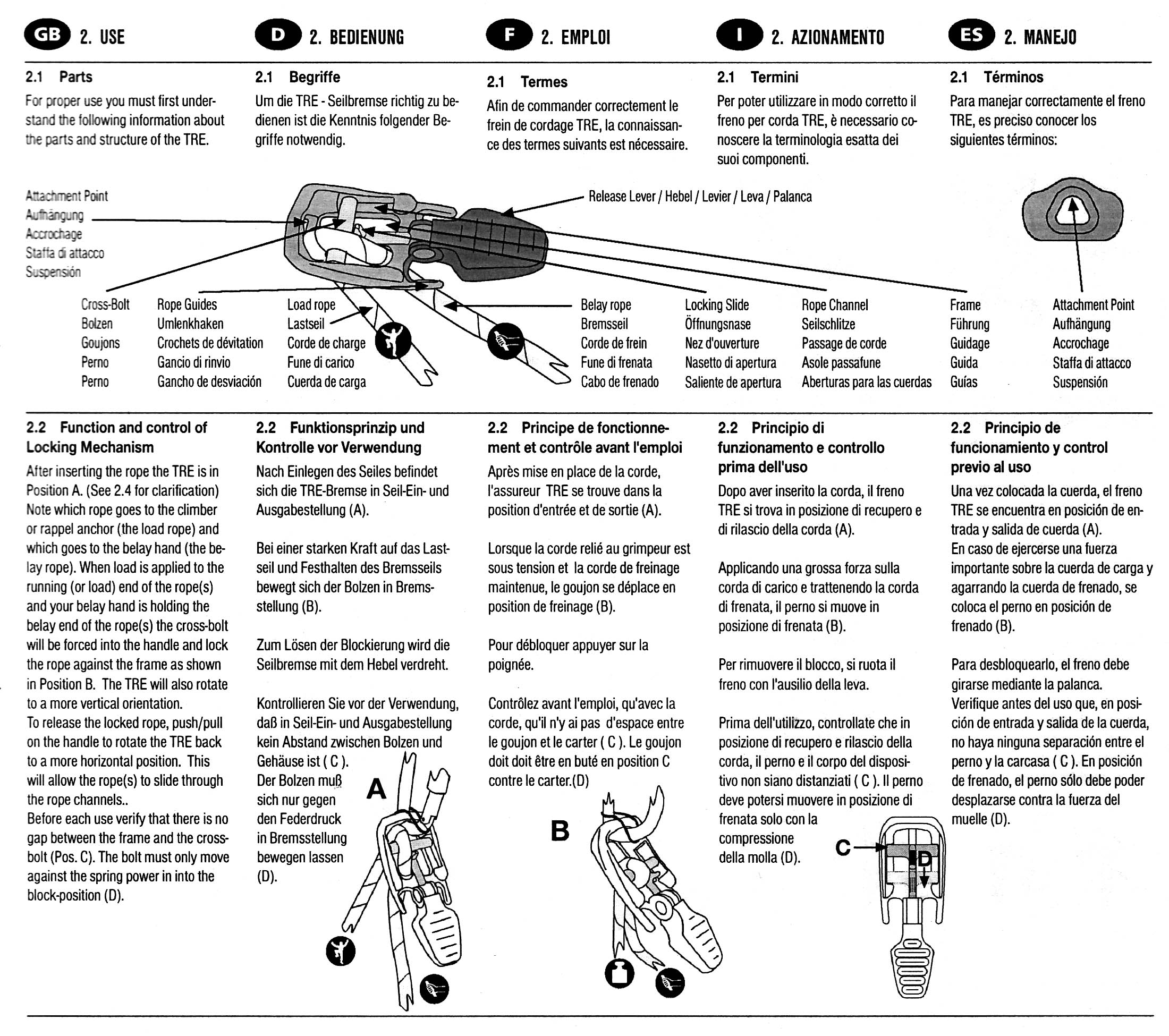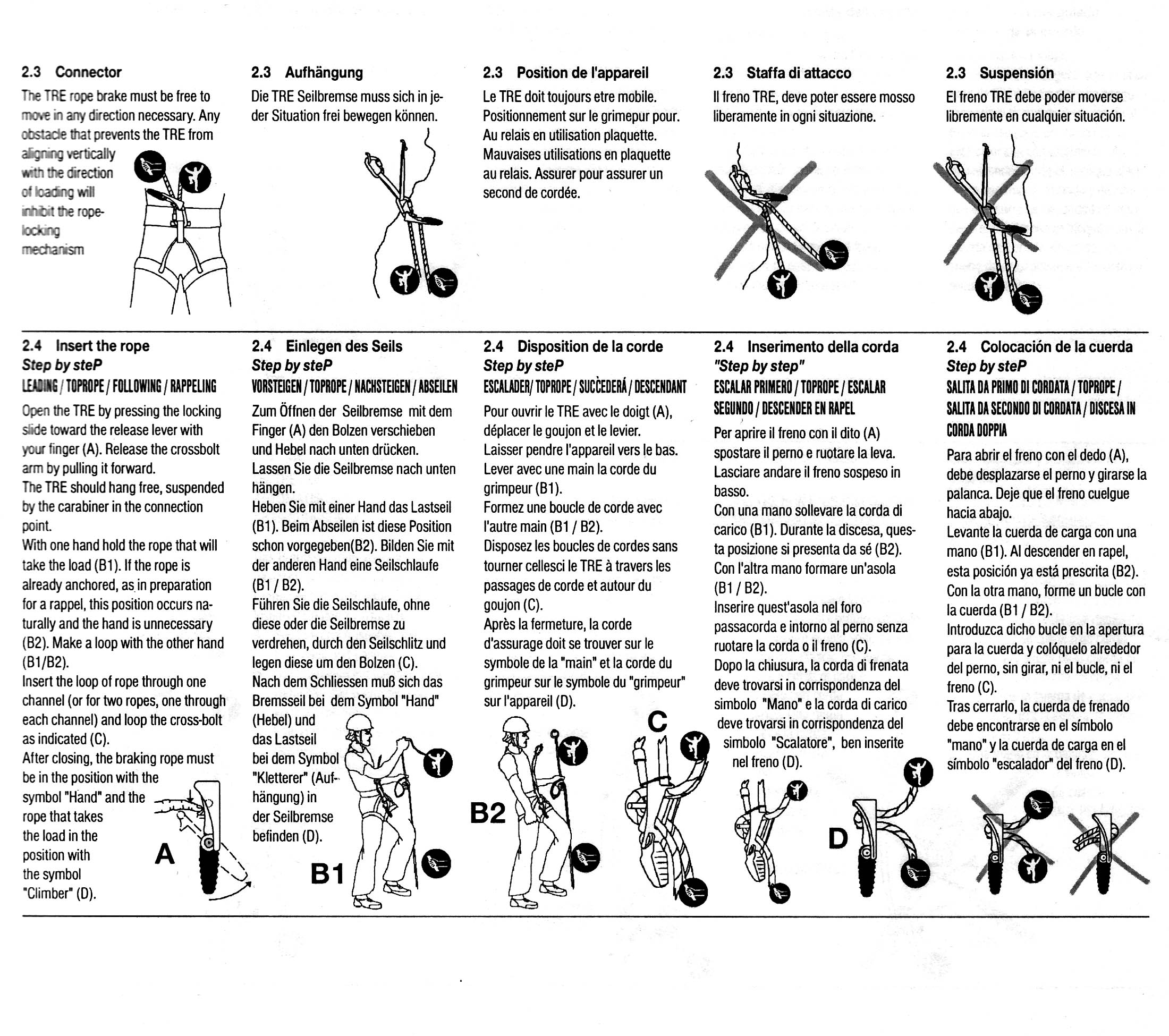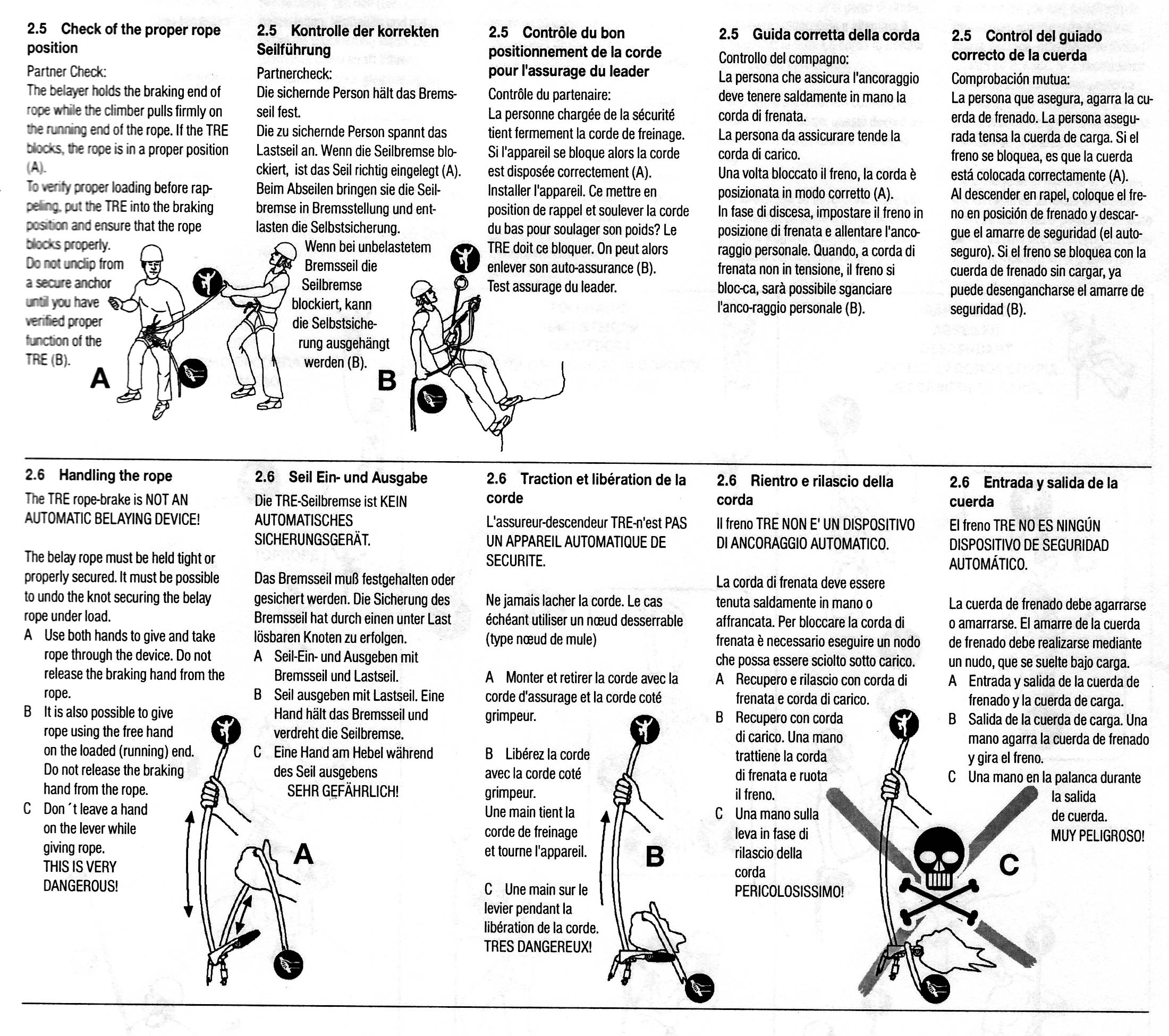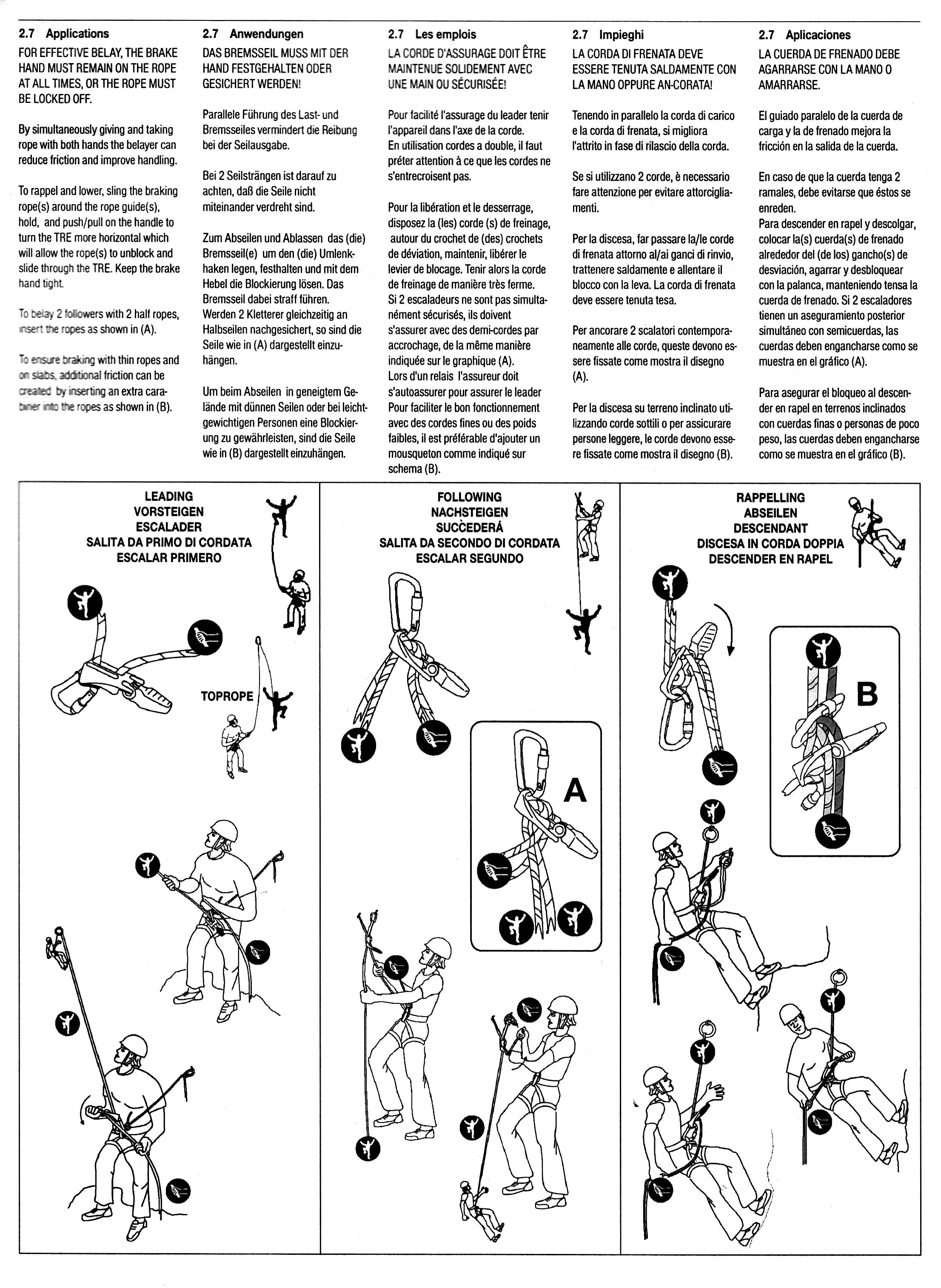Overview
[ Top
| Version B
| Return to Misc. Belay
]
Version A
(#772)
Technical Details
I acquired my Sirius from Barrabes.com in 2003.
The Sirius is a multi-function belay/rappel device. The main
frame is subrectangular, with two 52 mm. by 13 mm. slots, a subtriangular
carabiner hole set 90º to one end, and two small horns at
the other end. A plastic-covered handle pivots at the horn end.
A spring-loaded T-shaped bar rids in the handle. When the handle
is straight, an internal latch prevents pivoting the handle without
depressing the bar.
The frame and bolts are drop-forged, CNC-machined, and hard
anodized aluminum. The back has forged climber and hand icons
to show the rigging, "ONLY FOR ROPES EN 892 Ø 7.5-11
MM," and "LE" in a circle. The plastic handle is
marked with the TRE logo, "MADE IN GERMANY," "PATENT
PENDING," "CE0123," and the "reading
is dangerous" icon. It also has "TRE" printed
on the front.
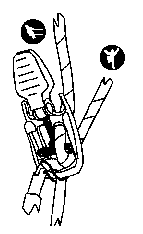
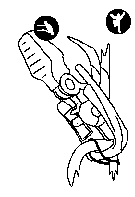 To rig
the TRE, depress the T-bar and open the TRE. Insert the rope(s)
in the slot(s), and close the device. Note that the rope to the
climber must exit from the end opposite the lever. I find this
to be counter-intuitive if I'm belaying a leader, since the lever
will be up and the rope to the leader above me will come out of
the bottom of the slot (see the figure at the left); however,
a little thought indicates that this is correct. If the leader
falls (not recommended), the standing rope will pull the T-bar
into the handle, locking the free end (belay hand end) between
the T-bar and the end of the slot(as shown in the right-hand figure).
To rig
the TRE, depress the T-bar and open the TRE. Insert the rope(s)
in the slot(s), and close the device. Note that the rope to the
climber must exit from the end opposite the lever. I find this
to be counter-intuitive if I'm belaying a leader, since the lever
will be up and the rope to the leader above me will come out of
the bottom of the slot (see the figure at the left); however,
a little thought indicates that this is correct. If the leader
falls (not recommended), the standing rope will pull the T-bar
into the handle, locking the free end (belay hand end) between
the T-bar and the end of the slot(as shown in the right-hand figure).
|
 |
Warning:
The TRE must be
free to move in any direction; otherwise it may not lock automatically. |
 |
|
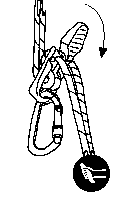
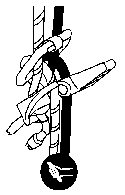 The Sirius can also
be used as a rappel device. Rig in the same manner as for belaying,
but run the rope up and over the horns. The Sirius will lock off,
so you will need to rotate the lever downward to move. I find
this rather annoying (I don't liked autostop descenders, for several reasons);
however, the tension from the rope weight below and the braking
hand helps. One can get extra friction by inserting a carabiner
in the rather convoluted position shown at the right. I don't
like the way the ropes run against each other, but there probably
is little harm done (witness the Munter
Hitch). Not only does the rope generate friction against the
carabiner and itself, but this arrangement takes the tension in
the trailing line off of the Sirius, increasing the force needed
to rotate the handle.
The Sirius can also
be used as a rappel device. Rig in the same manner as for belaying,
but run the rope up and over the horns. The Sirius will lock off,
so you will need to rotate the lever downward to move. I find
this rather annoying (I don't liked autostop descenders, for several reasons);
however, the tension from the rope weight below and the braking
hand helps. One can get extra friction by inserting a carabiner
in the rather convoluted position shown at the right. I don't
like the way the ropes run against each other, but there probably
is little harm done (witness the Munter
Hitch). Not only does the rope generate friction against the
carabiner and itself, but this arrangement takes the tension in
the trailing line off of the Sirius, increasing the force needed
to rotate the handle.
You can download the manual for the Sirius from the TRE
Web Site. Most of the belaying figures are drawn for belaying
a second, so the carabiner shows at the top. Keep this in mind
when belaying a climber above you.
[ Top
| Version A
| Return to Misc. Belay
]
Version B
(#810)
Technical Data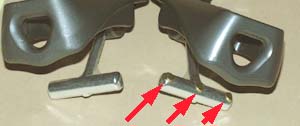
Thomas Reinhardt of TRE GmbH gave me Version B as an unsolicited donation in April 2005.
Version B adds three brass anti-friction pads to the T-bar.
The photograph shows the functional difference between Versions
A and B.
Version B has the same markings on the frame as Version A,
plus "04" in a stellated circle. The Plastic handle
markings are the same as in Version A, but the screening is rotated
180° from the one on Version A.
I would like to thank Thomas Reinhardt of TRE for donating
Version B to my collection.
The anti-friction pads let the T-bar slide easier. Under the
forces in a fall, this shouldn't make any noticeable difference,
but it may help the T-bar return to its normal position after
load is removed. If I hold the two Versions side-by-side, I notice
that Version B operates more smoothly, but in the field, I never
noticed Version A sticking (although I haven't tried it in cave
mud, which makes everything stick).
[ Top
| Version A
| Version B
]




 To rig
the TRE, depress the T-bar and open the TRE. Insert the rope(s)
in the slot(s), and close the device. Note that the rope to the
climber must exit from the end opposite the lever. I find this
to be counter-intuitive if I'm belaying a leader, since the lever
will be up and the rope to the leader above me will come out of
the bottom of the slot (see the figure at the left); however,
a little thought indicates that this is correct. If the leader
falls (not recommended), the standing rope will pull the T-bar
into the handle, locking the free end (belay hand end) between
the T-bar and the end of the slot(as shown in the right-hand figure).
To rig
the TRE, depress the T-bar and open the TRE. Insert the rope(s)
in the slot(s), and close the device. Note that the rope to the
climber must exit from the end opposite the lever. I find this
to be counter-intuitive if I'm belaying a leader, since the lever
will be up and the rope to the leader above me will come out of
the bottom of the slot (see the figure at the left); however,
a little thought indicates that this is correct. If the leader
falls (not recommended), the standing rope will pull the T-bar
into the handle, locking the free end (belay hand end) between
the T-bar and the end of the slot(as shown in the right-hand figure).
 The Sirius can also
be used as a rappel device. Rig in the same manner as for belaying,
but run the rope up and over the horns. The Sirius will lock off,
so you will need to rotate the lever downward to move. I find
this rather annoying (I don't liked autostop descenders, for
The Sirius can also
be used as a rappel device. Rig in the same manner as for belaying,
but run the rope up and over the horns. The Sirius will lock off,
so you will need to rotate the lever downward to move. I find
this rather annoying (I don't liked autostop descenders, for 